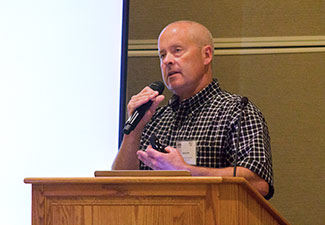Measuring Genetic Susceptibility to Disease
Task force is establishing guidelines to collect data indicating susceptibility to bovine respiratory disease.
by Raney Lovorn, Angus Journal® intern
BILOXI, Miss. (June 10, 2015) — Bovine respiratory disease (BRD) has a costly impact on the beef industry each year, especially in the feedlot sector. Mark Enns, Colorado State University, discussed the potential of a genetic correlation among feedlot and dairy animals treated for BRD each year during the 2015 Beef Improvement Federation Annual Convention in Biloxi, Miss., June 9-12.

If an EPD for BRD susceptibility were created, it would be seven times more economically important than postweaning gain or feed intake, Mark Enns said.
Studies have shown that BRD is up to 37% heritable, Enns said. More than 100 known genes impact an animal’s susceptibility to the disease.
“We are developing a case that there is a genetic contribution to susceptibility to bovine respiratory disease measured as a severity system or as a treated yes or no,” Enns said. “Therefore, knowing that, if you will, there is potential for genetic improvement of this trait.”
Due to the costly nature of the disease, Enns said, it would be an added value if producers could market more BRD-resistant cattle to feedlots.
The goal is to use what’s learned to develop selection tools to enable cow-calf producers to produce progeny that will be healthier in the feedlot and have lower treatment costs, Enns said. “That would probably be something like an EPD for susceptibility.”
If an EPD for BRD susceptibility were created, it would be seven times more economically important than postweaning gain or feed intake, Enns said.
Data collection and standardization poses the biggest problem for quantifying BRD. Enns said the way most data is collected only gives information as to whether the animals were treated for BRD or not, and more detailed treatment information is necessary.
“What we really need, if our goal is to produce a tool for breeders, is some standardization, and that is where BIF comes in,” Enns said, referring to the organization’s role in developing uniform guidelines for data collection and reporting. “The whole goal of this is to enable production of a selection tool, add accuracy to our selection and produce animals with lower treatment rates.”
In order to make a BRD selection tool a reality, BIF created a task force to create guidelines. The committee is a diverse group, with veterinarians that specialize in feedlot medicine, USDA professionals, individuals with BRD grant funding and university professionals.
Enns called the effort BIF’s first known attempt at establishing guidelines for a disease trait.
“We are breaking a little bit of new ground,” Enns said. “I anticipate these guidelines that we first come up with will be modified as we gain more knowledge.”
The committee will recommend a tiered data-reporting approach to the feedlot industry, Enns said. The system will give more flexibility to their research and allow for a wider variety of traits to be monitored with higher accuracy.
Tier 1 data will have specifics like animal identification, sex, in and out dates, and owner of origin. Feedlots are already collecting the majority of this data, Enns said. For BRD information, the committee would like the date the calf was diagnosed, date treated and temperature at treatment, which currently has a 74% recording rate at the feedlot.
Tier 2 would depend on the feedlot’s comfort in sharing the information with the owner of origin, who could submit that data to breed associations for analysis, Enns explained.
The guideline committee plans to submit a final recommendation to the BIF board of directors at its mid-year meeting, he concluded.
The 2015 BIF Annual Convention was hosted by Mississippi State University and the Mississippi Extension Service June 9-12 at the Beau Rivage Casino and Hotel in Biloxi. The Angus Journal and LiveAuctions.tv provide comprehensive online coverage of the event at www.BIFconference.com. Visit the Newsroom for summaries, proceedings, PowerPoints and audio of the sessions; the Awards page for announcements of award winners; and the Photos page for photo galleries of the tour stops.
Editor’s Note: This summary was written under contract or by staff of the Angus Journal®. Through an agreement with the Beef Improvement Federation, we are encouraging reprinting of the articles to those who will adhere to the reprint guidelines available on this site. Please review those guidelines or contact Shauna Rose Hermel, editor, at 816-383-5270. PowerPoints are posted with permission of the presenter and may not be reproduced in whole or in part without the express permission of the presenter.
The Angus Journal's coverage of the event is made possible through collaboration with BIF and sponsorship of LiveAuctions.tv. For questions about this site, or to notify us of broken links, click here. Look for additional coverage in the Angus Journal, the Angus Beef Bulletin, the Angus Journal Daily, the Angus Beef Bulletin EXTRA and Angus TV.



